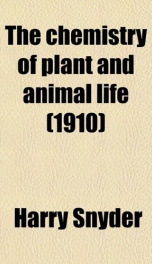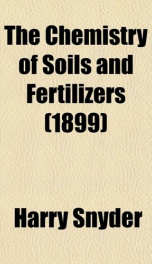the chemistry of plant and animal life

Purchase of this book includes free trial access to www.million-books.com where you can read more than a million books for free. This is an OCR edition with typos. Excerpt from book: CHAPTER II Properties of Elements and Compounds 13. Physical Properties.In order to determine the value of any element or compound, a knowledge of its chemical and physical properties is necessary, and it is important that a clear idea be obtained as to what is meant by the terms chemical and physical properties of elements and compounds. Each element and compound has its ow,n characteristic properties, which are different in a number of ways from those of other elements and compounds. The physical properties of a substance include : 1. Form or state of the material, as solid, liquid, or gas, which depends upon the temperature to which the substance is subjected. Many substances which are solid under ordinary conditions are, at higher temperatures, converted into liquids or vapors ; and substances which are gases are in turn converted into liquids and solids at low temperature and under high pressure. 2. Weight or specific gravity. The weight or specific gravit)' of a material depends upon its molecular structure and upon the character of its individual molecules. Some of the elements and compounds have molecules of greater weight than have others. Liquids and gases are characterized as light or heavy according to their weight, compared with some material taken as the standard. 3. Color. The color of a compound is a physical property which is due to its chemical composition. Many ofthe elements, as copper, silver, and gold, have characteristic colors. Some compounds owe their value entirely to their color, and are used for paints and dyes. 4. Odor and taste. The odor and taste of an element or compound are physical properties which are characteristic of the element or compound. 5. Electrical characteristics. Elements and compounds have definite electrical proper...
Info about the book
Author:
Series:
Unknown
ASIN:
B008K6K5J2
Rating:
3.5/5 (5)Your rating:
0/5
Languge:
English
Users who have this book
Users who want this book
What readers are saying
What do you think? Write your own comment on this book!
write a commentif you like the chemistry of plant and animal life try:
Other books by this author
Do you want to read a book that interests you? It’s EASY!
Create an account and send a request for reading to other users on the Webpage of the book!




